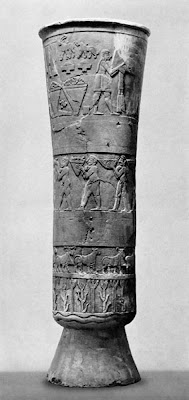"There is no such thing as art. There are only artists"
The dictum by Gombrich, in the introduction of his well-known The Story of Art , is perhaps less “clear” than it may appear at first. To apparently "shift" the problematic of art from objects, categories and processes to the agent, the producer, does not eliminate the need to clarify the concept “art” itself.
For it is evident that the artist, as a producer, is defined by his product. An artist is somebody who makes art. To identify the artist we must be able “first” to tell, to identify, to know the artistic product, therefore to say both what is art and what art “is”.
Gombrich’s “shift” may bring to mind other attempts to a “reductive” approach to the History of Art, such as Wolfflin’s “Art History Without Names”, or The History of Art as the History of Styles in their inner, that is logical-formal, developments, what we may call: the notion of artistic style as structure.
But certainly Gombrich’s formula was not intended as an attempt to an “original” art historical method, but rather, in a more concise or simplified way, to introduce the problematic at the core of the art historical discipline. Namely, the relative constant presence at different times and places of image making activities and related “artistic”, that is, formal-symbolic practices, and the rather restricted modern notion of Art, “with a capital A”, in regard to the diversity of contexts and functions of the form-making activities in history.
In other words, the “universalism” of the very notion of a (unique, self-identical, continuous) History of Art, developing from Prehistoric times to the present, encompassing centuries, territories, cultures and a great diversity of forms of activities and meanings, has its origin in the Renaissance. It takes its definite form in the 19th century and is predicated on a vision constructed mainly from the European experience. An experience that culminates in the "L'art pour l'art" or “Art for Art’s Sake” idea of the late 19th and early 20th centuries.
"L'art pour l'art" is also, contrary to appearances, less of a clear response to the question of art than the very index or summary of the complexity of the problem of art as developed in history and in theory in the construction of the Modern World and the Modern Experience.
“Art with a capital A has become something of a bogey and a fetish”, writes Gombrich. In other words, a ghost to be exorcised so the beginner can be lured into the realm of the history of artistic practices and products leaving at the door some of his anxieties, his assumptions or prejudices.
“There are no wrong reasons for liking a statue or a picture.[ …] There are wrong reasons for disliking a work of art”, writes the art-historian. And the beginner may be allowed, after all, to keep at least some of his assumptions or prejudices. The price to be paid for a liberal lesson on “formal tolerance”?
For it is evident that the artist, as a producer, is defined by his product. An artist is somebody who makes art. To identify the artist we must be able “first” to tell, to identify, to know the artistic product, therefore to say both what is art and what art “is”.
Gombrich’s “shift” may bring to mind other attempts to a “reductive” approach to the History of Art, such as Wolfflin’s “Art History Without Names”, or The History of Art as the History of Styles in their inner, that is logical-formal, developments, what we may call: the notion of artistic style as structure.
But certainly Gombrich’s formula was not intended as an attempt to an “original” art historical method, but rather, in a more concise or simplified way, to introduce the problematic at the core of the art historical discipline. Namely, the relative constant presence at different times and places of image making activities and related “artistic”, that is, formal-symbolic practices, and the rather restricted modern notion of Art, “with a capital A”, in regard to the diversity of contexts and functions of the form-making activities in history.
In other words, the “universalism” of the very notion of a (unique, self-identical, continuous) History of Art, developing from Prehistoric times to the present, encompassing centuries, territories, cultures and a great diversity of forms of activities and meanings, has its origin in the Renaissance. It takes its definite form in the 19th century and is predicated on a vision constructed mainly from the European experience. An experience that culminates in the "L'art pour l'art" or “Art for Art’s Sake” idea of the late 19th and early 20th centuries.
"L'art pour l'art" is also, contrary to appearances, less of a clear response to the question of art than the very index or summary of the complexity of the problem of art as developed in history and in theory in the construction of the Modern World and the Modern Experience.
“Art with a capital A has become something of a bogey and a fetish”, writes Gombrich. In other words, a ghost to be exorcised so the beginner can be lured into the realm of the history of artistic practices and products leaving at the door some of his anxieties, his assumptions or prejudices.
“There are no wrong reasons for liking a statue or a picture.[ …] There are wrong reasons for disliking a work of art”, writes the art-historian. And the beginner may be allowed, after all, to keep at least some of his assumptions or prejudices. The price to be paid for a liberal lesson on “formal tolerance”?


Comments